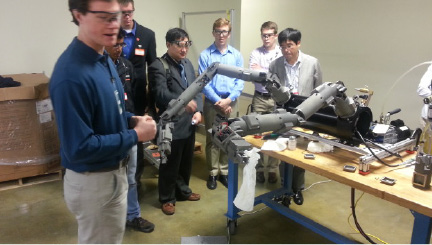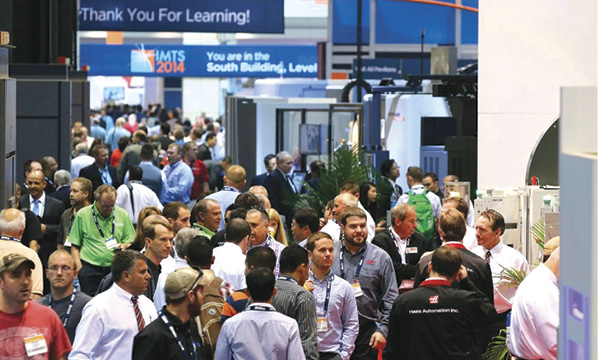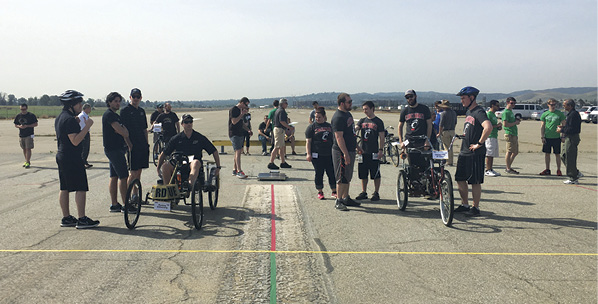Is Additive Manufacturing an Opportunity or a Threat for the Fluid Power Industry?
By Eric Lanke, NFPA CEO

I’ve been asked that question more than once in the past few months, mostly by NFPA members who are beginning to examine the emerging technology of additive manufacturing and make the determination for themselves.
I got a good look at some possible additive manufacturing applications for fluid power on my recent tour of the Manufacturing Demonstration Facility (MDF) for additive manufacturing at the Oak Ridge National Laboratory (ORNL) in Tennessee. Our friends at the CCEFP helped arrange the tour on the tail end of the Fluid Power Innovation and Research Conference in October, and it was quite an eye-opening experience for me and the forty-some members of the fluid power industry that chose to participate.
In case you’re not familiar with the term, additive manufacturing is more commonly known as 3D printing—the process of “growing” a part from nothing, layer by layer, rather than starting with a hunk of metal and cutting or machining it down to the part you need. And ORNL has invested heavily in the technology, opening the MDF and making its resources available for a whole host of industries to experiment with, including fluid power. Dr. Lonnie Love runs the MDF, and he has a strong interest in fluid power, having served for the last nine years as one of CCEFP’s scientific advisors.
In the attached photo, we see one of Lonnie’s team members demonstrating the hydraulic-actuated robot arms that they recently printed, partly as an experiment and partly in an attempt to create a set of robotic arms to aid with undersea exploration and salvage operations. The first amazing thing about the arms is that they are made of titanium. That’s one of the new technologies that the MDF is quietly advancing—the ability to print in a variety of different metals—not just in the plastics and polymers that we traditionally associate with 3D printing. But things get more interesting when you look more closely at the arms. They are fully hydraulic, but there are no hoses or couplings. All the fluid pathways are internal to the structure—even through each of the joints—something that is just plain impossible to do with traditional manufacturing techniques. The valves that help control movement are also printed directly into the structure of each joint.
It’s a great example of what additive manufacturing makes possible for fluid power applications. Because of all this internal architecture—“grown” whole from the bottom up, rather than machined component by component then pieced together—the arms are extremely lightweight (they are, in fact, buoyant in the water they’re designed to work in) and, remarkably, they DO NOT LEAK. Since the fluid pathways are all enclosed in one continuous circuit, there’s no way for the hydraulic fluid to leak out. It completely changes the way one thinks about what’s possible with fluid power systems.
Two arguments I’ve heard against additive manufacturing for our industry can be boiled down to
- It threatens my core business. Well, yes, I suppose it does, if you define your core business by how you make your product rather than by the customer problem you’re trying to solve. If you’re in the “making fluid power components with traditional manufacturing” business, then additive is a disruption in your marketplace that you’d better fight against. But if you’re in the “providing my customers with controllable power” business, then you may find uses and applications for additive that can help you do that better than your competitors.
- I need more machinists, not new technologies. This is probably the most common concern I hear from NFPA members. And it certainly is a pain point for them, for our industry, and for dozens of other industries like ours. But additive may be a technology that warrants a re-thinking of this instinctual desire. Ask yourself, will there be any machinists in the future? People with mechanical aptitude, yes, of course there will always be those, but how will that aptitude be best leveraged by the fluid power industry in the future? By drilling holes and other traditional methods of manufacturing parts? Or by controlling flow architecture in new and inventive ways? Maybe the solution to the machinist workforce problem isn’t training young people in traditional technologies, but rather transforming a traditional industry in a way that engages young people with new technologies?
I’m not trying to convince you one way or the other. But I do think the questions are worth asking and the discussion is worth having.
We’re currently looking for other ways to leverage this technology for fluid power applications. Through the CCEFP’s Industry Engagement Committee, we’re going to be sponsoring several fluid power-related projects with the MDF and sharing the results with our membership. If you’ve got ideas for how to apply additive manufacturing for fluid power and would like to be a part of the project team that connects with the MDF on these subjects, let me know.
We’ll also be taking a closer look at additive manufacturing at the upcoming 2015 NFPA Annual Conference in San Diego. We’ve invited Alex Chausovsky, senior principal analyst at Industrial Automation for IHS Technology, to help us dissect the subject. He’s been doing a lot of research into additive manufacturing, specifically from a fluid power perspective, and will have some thought-provoking information to present.
Focusing on new and emerging technologies, like additive manufacturing, and deciding how our industry can best benefit from them is a big part of NFPA’s core strategic priority of helping to foster an innovative environment for the fluid power industry.






